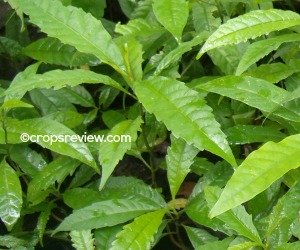Vitex parviflora Juss. is the scientific name of the small-flower chaste tree, also called the molave or tugas tree.
The name was authored by Antoine Laurent de Jussieu (1748-1836), a French botanist, hence the Juss. after the scientific name.
One of its synonyms, Vitex littoralis, was authored by another French botanist, Joseph Decaisne (1807-82), abbreviated Decne.
The molave or V. parviflora belongs to the Verbena family or Verbenaceae, order Lamiales, group Asterids of the Eudicots, under phylum Angiospermae (also called Magnoliophyta or Anthophyta) of the kingdom Plantae (Simpson 2010).
The family is also called the Molave family (Merrill 1912). Verbena is a Latin word referring to plants with clusters of flowers of various colors.
Branches of these plants were worn by heralds and priests as a sacred symbol (Traupman 1995).
The taxonomic family Verbenaceae includes herbs, vines, shrubs, and trees, mostly tropical. Aside from Verbena and Vitex, some other important genera under this family are the following:
Aloysia, Avicennia, Callicarpa, Clerodendron, Congea, Cytharoxylum, Duranta (ex. D. repens), Gmelina (ex. G. elliptica Sm.[dadiangas, talungon]), Holmskioldea, Lantana (ex. L. camara), Lippia, Petraea, Premna, Stachytarpheta, Symphorema, and Tectona (ex. T. grandis or teak) (Merrill 1912; Steiner 1986; Simpson 2010).
E.D. Merrill, in his book Flora of Manila published in 1912, described the molave tree (Vitex parviflora Juss.) which flowered from May to October.
He also described two lagundi shrubs which are close relatives of molave, the Vitex negundo L. and the Vitex trifolia L.
Here’s Merrill’s entry on page 404 of the book: 1. V. parviflora Juss. (V. littoralis Dene.). Molauin, Molave Tag.).
A tree with very hard wood, reaching a height of from 8 to 15 m, glabrous or nearly so, or the inflorescence puberulent. Leaflets 3, petioled, ovate to lanceolate, 7 to 18 cm long, shining, quite glabrous. Inflorescence terminal, paniculate, ample, up to 20 cm long, usually somewhat pyramidal, many-flowered. Flowers blue, 6 to 8 mm long, usually the corolla pubescent outside. Fruit globose or subglobose, 5 to 6 mm in diameter.
(Fl. Filip. Pl. 227, V. altissima.)
In dry thickets Masambong, fl. May-Oct.; common and widely distributed in the
Philippines. Timor.
But Vitex parviflora can grow much larger than Merrill (1912) described.
According to WAC (2013), molave is a medium to large tree with butresses, capable of growing to a height of 30-38 m with bole diameter up to 125-200 cm and branches up to 20 m.
Its bark is smooth, or nearly so. It usually has a spreading crown.

Seedlings of molave (Vitex parviflora)
Leaves are palmately compound with 3 leaflets (trifoliate), petioled.
Leaflets are ovate to lanceolate 7 to 18 cm long with pointed tip, shining and quite smooth (stuartxchange .com 2012).
Flowers are perfect or bisexual having both pistil (carpel) and stamen in the same flower structure.
The fruit is a drupe, bluish-black when mature with 1-4 seeds.
The seeds are obovoid to oblong without endosperm. There are about 10,000-18,000 seeds per kilogram.
Accordingly, Vitex parviflora is native to the Philippines, Sulawesi, Timor, and the Moluccas (WAC 2013).
It appears, however, that the leaves are not entirely compound, particularly in seedlings of the common strain locally called tugas babae (see photo of seedlings).
Similarly, according to ERDB (2008), the leaves are mostly single and generally opposite or whorled.
This tree can grow in any soil but prefers dry limestone soils.
It grows from sea level to about 600 masl in clayey to sandy loam soils and needs plenty of sun (ERDB 2008).
It is adapted to rainfall below 400 mm annually (Fernandez 1993).
Late in the dry season, it undergoes partial or total defoliation (leaf shedding) (WAC 2013).
Further, planted molave trees start flowering in 5-6 years after planting. Fruits ripen after a few months from pollination.
Seed germination starts 10-40 days after sowing.
In the Philippines, it is generally planted using bare-root seedlings with planting distance of 2 m x 2 m.
A plantation yielded 76 cubic meters (equivalent to 2,683.91 cubic feet) per hectare after 20 years.
Annual growth increment of 0.4-1 m in height and 0.7-1 cm in diameter was reported (WAC 2013).
LITERATURE CITED
[ERDB] Ecosystems Research and Development Bureau. 2008. Moluccan sau and molave. Vol. 20 No. 3 2008. Research Information Series on Ecosystems. ERDB, College 4031, Laguna. Retrieved Aug. 25, 2013 from http://erdb.denr.gov.ph/publications/rise/r_v20n3.pdf.FERNANDEZ PG (ed.). 1993. Agroforestry Species in the Philippines: Common Names, Seed Sources, and Growth Requirements. Agroforestry Seeds Circular No. 3 Supplement. UPLB, Laguna, PH: AFSICH. 20 p.
MERRILL ED. 1912. A Flora of Manila. Manila: Bureau of Printing. p. 396-406.
SIMPSON MG. 2010. Plant Systematics. 2nd ed. San Diego, CA: Elsevier Inc. 740 p.
STEINER ML. 1986. Philippine Ornamental Plants and Their Care. 3rd ed. Las Piñas, Metro Manila: M&L; Licudine Ent. 233 p.
STUARTXCHANGE.COM. 2012. Molave, Vitex parviflora Juss., small-flower chaste tree: Philippine medicinal herbs / alternative medicine. Retrieved August 26, 2013 from http://stuartxchange.com/Molave.html.
TRAUPMAN JC. 1995. The New College Latin & English Dictionary. New York, NY: Bantam Books. p. 440.
[WAC] WORLD AGROFORESTRY CENTRE. 2013. Species information: Vitex parviflora. Retrieved Aug. 24, 2013, from http://www.worldagroforestrycentre.org/sea/products/afdbases/af/asp/SpeciesInfo.asp?SpID=17969.I Tugas Babae vs. Lanhan I Molave Uses I Molave Propagation I Molave Bonsai I
